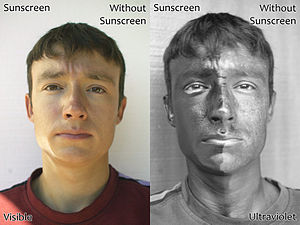Potential health risks
As a defense against UV radiation, the amount of the brown pigment melanin in the skin increases when exposed to moderate (depending on skin type) levels of radiation; this is commonly known as a sun tan. The purpose of melanin is to absorb UV radiation and dissipate the energy as harmless heat, blocking the UV from damaging skin tissue. UVA gives a quick tan that lasts for days by oxidizing melanin that was already present and triggers the release of the melanin from melanocytes. UVB on the other hand yields a tan that takes roughly two days to develop because it stimulates the body to produce more melanin. The photochemical properties of melanin make it an excellent photoprotectant.
Sunscreen chemicals on the other hand cannot dissipate the energy of the excited state as efficiently as melanin and therefore the penetration of sunscreen ingredients into the lower layers of the skin increases the amount of free radicals and reactive oxygen species (ROS).[5]
Some sunscreen lotions now include compounds such as titanium dioxide which helps protect against UVB rays. Other UVA blocking compounds found in sunscreen include zinc oxide and avobenzone. There are also naturally occurring compounds found in rainforest plants that have been known to protect the skin from UV radiation damage, such as the fern Phlebodium aureum.
Some sunscreen chemicals produce potentially harmful substances if they are illuminated while in contact with living cells.[26][27][28] The amount of sunscreen which penetrates through the stratum corneum may or may not be large enough to cause damage. In one study of sunscreens, the authors write:
The question whether UV filters acts on or in the skin has so far not been fully answered. Despite the fact that an answer would be a key to improve formulations of sun protection products, many publications carefully avoid addressing this question.[29]
In an experiment by Hanson et al. that was published in 2006, the amount of harmful reactive oxygen species was measured in untreated and in sunscreen-treated skin. In the first 20 minutes the film of sunscreen had a protective effect and the number of ROS species was smaller. After 60 minutes, however, the amount of absorbed sunscreen was so high that the amount of ROS was higher in the sunscreen-treated skin than in the untreated skin.[5]
George Zachariadis and E Sahanidou of the Laboratory of Analytical Chemistry, at Aristotle University, in Thessaloniki, Greece, have now carried out an ICP-AES analysis of several commercially available sunscreen creams and lotions. "The objective was the simultaneous determination of titanium and several minor, trace or toxic elements (aluminum, zinc, magnesium, iron, manganese, copper, chromium, lead, and bismuth) in the final products," the researchers say. They concluded that "Most of the commercial preparations that were studied showed generally good agreement to the ingredients listed on the product label." However, they also point out that the quantitative composition of the products tested cannot be assessed because the product labels usually do not provide a detailed break down of all ingredients and their concentrations. They also point out that, worryingly, their tests consistently revealed the presence of elements not cited in the product formulation, which emphasized the need for a standardized and official testing method for multi-element quality control of these products.[30]
Some epidemiological studies indicate an increased risk of malignant melanoma for the sunscreen user.[31][32][33][34][35][36][37][38] Despite these studies, no medical association has published recommendations to not use sunblock. Different meta-analysis publications have concluded that the evidence is not yet sufficient to claim a positive correlation between sunscreen use and malignant melanoma.[39][40]
Adverse health effects may be associated with some synthetic compounds in sunscreens.[41] In 2007 two studies by the CDC highlighted concerns about the sunscreen chemical oxybenzone (benzophenone-3). The first detected the chemicals in greater than 95% of 2000 Americans tested, while the second found that mothers with high levels of oxybenzone in their bodies were more likely to give birth to underweight baby girls.[42]
The use of sunscreen also interferes with vitamin D production, leading to deficiency in Australia after a government campaign to increase sunscreen use.[43] Doctors recommend spending small amounts of time in the sun without sun protection to ensure adequate production of vitamin D.[44] When the UV index is greater than 3 (which occurs daily within the tropics and daily during the spring and summer seasons in temperate regions) adequate amounts of vitamin D3 can be made in the skin after only ten to fifteen minutes of sun exposure at least two times per week to the face, arms, hands, or back without sunscreen. With longer exposure to UVB rays, an equilibrium is achieved in the skin, and the vitamin simply degrades as fast as it is generated.[45]
Concerns have been raised regarding the use of nanoparticles in sunscreen.[46] Theoretically, sunscreen nanoparticles could increase rates of certain cancers, or diseases similar to those caused by asbestos.[47] In 2006 the Therapeutic Goods Administration of Australia concluded a study and found:
"There is evidence from isolated cell experiments that zinc oxide and titanium dioxide can induce free radical formation in the presence of light and that this may damage these cells (photo-mutagenicity with zinc oxide). However, this would only be of concern in people using sunscreens if the zinc oxide and titanium dioxide penetrated into viable skin cells. The weight of current evidence is that they remain on the surface of the skin and in the outer dead layer (stratum corneum) of the skin." [








